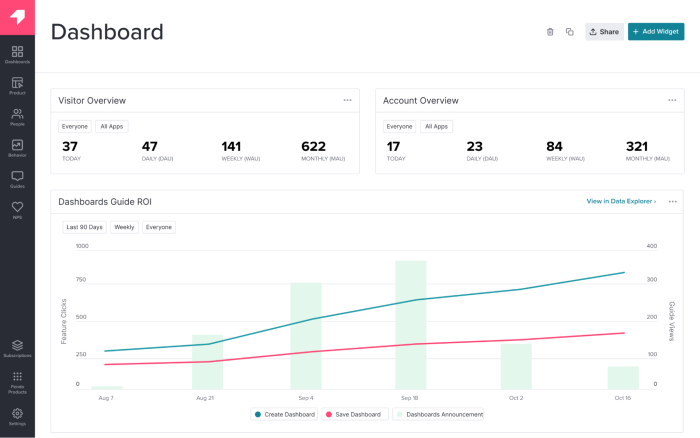2025 is well and truly at full sprint and product-led growth is now proving to be the most cost-effective way for SaaS companies to grow. Not only is it cost-efficient when it comes to customer acquisition, but it’s also doing wonders for businesses looking to put retention goals above the rest.
That being said, your product-led growth stack may be a little outdated. What with the drastic emergence of some pretty nifty AI tools, and SaaS brands getting more competitive than ever to serve up piping-hot new features, the ideal product-led growth stack has changed quite a bit in recent months.
Ready to get into it?
Product-led growth is the most cost-effective way for SaaS companies to grow in 2025
The ideal product-led growth stack has changed with the emergence of AI tools and increased competition
A product-led growth stack is a set of tools for product managers to work more efficiently and effectively
The stack includes categories such as user onboarding, in-product engagement, self-serve support, user feedback, product analytics, and A/B testing
10 must-have tools for your product-led growth stack are: Chameleon, Pendo, Olark, Intercom Fin, Zendesk, Stonly, Survicate, Typeform, MixPanel, and Kameleoon
These tools cover user onboarding, in-product engagement, self-serve support, user feedback, product analytics, and A/B testing.
What is a product-led growth stack?
A product-led growth stack is a set of tools a product manager needs in order to get their job done quicker, more efficiently, and more effectively. This tech stack comes with a range of categories:
User onboarding
In-product engagement
Self-serve support
User Feedback
Product analytics
A/B testing
Of course, the list doesn’t stop there, but this should provide you with a great place to start building a list of tools.
This tech stack will enable product teams to deliver a product-led go-to-market model by making the most of cross-team resources, customer and user data, as well as implementing product changes based on those findings.
10 Must-have tools in your PLG tech stack
Without further ado, let’s get into these vital product-led resources that will have you sweet-talking finance for more budget.
Not to worry though, if that doesn’t work, some of these tools come with a startup-friendly freemium version or unlimited user free trial. Both of which will soon get you that internal buy-in you need.
Your one-stop-shop for user onboarding tools
User onboarding tools should be at the top of every product team’s list. Whether you’re looking at retention, acquisition, or churn, product-led growth all starts at user onboarding. It’s not just a tool to keep users engaged. It's a sales tool. Do it well and let it do itself.
Let’s go.
1. Chameleon

Where would we be if we didn’t put ourselves on the list? Chameleon has come a long way over the last year. We’ve now had a shiny-new rebrand and have launched HelpBar to our product stack—which is a plug-and-play spotlight search widget.
HelpBar brings our products up to a total of five alongside:
Tours: helping to drive product usage and adoption rates for new users or new features
Tooltips: unblocking users on certain items, while keeping them on track to completing their job
Surveys: in-product check-ins and pulse checks for on-the-go customer data collection
Launchers: customizable in-product widgets to build user engagement
“Best user engagement platform: Easy to use, wide range of survey and tour types, more flexibility than the competitors I have used. Chameleon opened up one of the most important ways for us to communicate with our users.”—G2 Review.
2. Pendo

Understand what your users are doing, guide them through their goals, and gather feedback as you go. Pendo offers user onboarding, but its real selling point is having advanced analytics to monitor and analyze your production adoption metrics. It also enables product teams to better communicate product priorities with cross-team roadmaps, and now includes an additional product: Data Sync.
Data Sync allows teams to export enriched event data to a cloud data warehouse destination of your choice. This enables multiple teams to share and collaborate on data sets and larger business intelligence info in order to take action to drive product-qualified leads more collaboratively: across marketing campaigns, sales team efforts, product updates, and more.
“Powerful data collection to enable data-driven decision making: fairly user-friendly, most everything can be done via UI tools but also allows powerful customizations via javascript. Love the ability to track the usage of our apps and the adoption of new features with quantifiable data points that can then be used to support or modify roadmap decisions.”—G2 Review.
In-product engagement tools to get users talking
Most PMs realize the importance of a solid user engagement strategy and the in-app customer experience. Engaged users are often happy users—minus the rage clicks. So, getting users to stay engaged, and coming back to your platform is a recipe for increasing CLTV.
Although a good worker never blames their tools, let’s take a look at some fantastic user engagement tools that will certainly have you muttering your thanks.
3. Olark

Marketing automation tools are hot property, and Olark’s got to be up there as one of the best. The team has developed 24/7 affordable customer service with AI-powered chat. CoPilot allows sales teams to automate lead and sales engagements and prioritize contacts in your CRM.
If you’re looking at implementing an in-product engagement tool for streamlined customer support, then Olark can be your go-to when your humans aren’t. With 79% of customers saying they prefer live chat over email or phone, you’ll be building a product to answer the majority.
"Easy communication with your users/customers: I loved being able to connect instantly with our customers and answer their questions and assist them with their support immediately. It made things seem more personable and put names to our customers who use our products. It allowed us to help and get instant feedback.”—G2 Review.
4. Intercom Fin

Meet Fin, the tool enabling your customer service team to solve 50% of customer support issues instantly. Intercom released an AI service chatbot powered by Open AI’s Chat GPT 4. The AI bot has managed to deflect 60% of support tickets from CS teams and only provides answers based on your support content—meaning no false information.
“Fin has really exceeded our expectations. Within the first week of testing, our automated resolution rate increased from 18% to 29%. We thought maybe we'd see a three or four point change, but an 11 point increase is amazing!”—Website review.
Self-Serve support tools to empower happy users
Just like anyone in an agile team, time is a valuable asset. Self-serve support aims to save time for customer success teams, enable marketing teams to do their jobs better, and all while providing a more autonomous in-app experience for users. Spoon-feeding is overrated.
Let’s take a look at the top self-serve customer support tools you need to know about and why.
5. Zendesk
Zendesk is a common name for most in the SaaS industry. The popular omnichannel support suite has been around for a while and enables your business to foster natural conversations with customers and users alike. But, their game has changed in 2024. Let’s take a look.
Zendesk now offers:
AI-powered conversational experiences: using advanced bots to respond and tag queries so agents can get to them quicker and more accurately.
Advanced AI tools: intelligent triage, intelligence in the context panel, and macro suggestions for admins. Zendesk is putting AI to work to enable your product team to provide faster, seamless customer support.
6. Stonly

What if we told you there actually was a one-size-fits-all solution to self-serve support? You’d probably cringe at the overused expression, right? But, Stonly seems to have finally justified its use. They’re providing hyper-tailored self-serve support options for users—guiding them down their aha! moment pathways and reducing your TTV and churn rates.
“User friendly: Stonly has taken internal and external-facing troubleshooting flows and allowed us to format them in a user-friendly interface. Our handling time is steadily decreasing and our customer experiences are much more consistent.”—G2 Review.
User feedback PLG tools to get data quickly and effectively
In order for sales teams to do great work and keep generating product-qualified leads you’ll need user feedback. Markets change, sentiments change, and competition changes faster than all of them. These are the top user feedback tools to keep your team on their toes.
7. Survicate

Survicate offers customer feedback surveys designed to help you understand your product KPIs better. Accurately measure things like NPS, CSAT, CES, and more, and integrate your forms into the communication strategies your customers are used to: in-product, on your site, via a link, as well as email, and it’s all totally adaptable to the user’s device.
Their free plan is also pretty appealing if you’re looking to dabble into the depths of user feedback for the first time. The free plan offers unlimited responses, and there’s no credit card required—phew!
8. Typeform

Typeform has been in the game for a while, and they’ve been a leader in the user feedback space for a very good reason. They’re known for their user-friendly, drag-and-drop forms that enable you to gather quantitative and qualitative feedback from customers that’s a joy for the questionnaire maker and the taker.
What you might not know, is that Typeform’s personalized flows enable you to carve out user feedback forms that adapt to responses, allowing your team to dive into the weeds of feedback, without needing to send out any more comms based on responses.
Want more? Check out their sister brand: VideoAsk, to give a more personal touch to customer feedback and incorporate video into your product and user research team’s customer communication.
Product analytics for practical product usage data
Product analytics and product usage data is no longer just for data scientists. A solid customer data platform can present data to all of your team members, no matter how numbers-friendly their mind is. With accessibility top of mind, this is the top product analytics tool for tracking customer data, understanding it, and implementing findings in your PLG strategy.
9. MixPanel
MixPanel is a go-to product analytics tool to help you go from data to decision. It enables PMs to hypothesize, validate, decide, and run an outcome going on event data from your web or mobile apps.
Now, what’s new with MixPanel is where things get spicy. The team has introduced custom alerts, anomaly detection, and root cause analysis features. This is fabulous. You’re able to set up custom alerts when a data point you’re tracking hits a high or low threshold (success or worry). But, if you don’t know what that threshold should be, then anomaly detection can do it for you going on data history.
Then, you’re able to run a root cause analysis, to drill back and down into why your metric hit that threshold in the first place. What was the game-changer? Mixpanel is eradicating the manual effort of tracking metrics, so the metrics can just track themselves—and no, this is not an ad!
A/B testing for actionable customer data
Oh, the joys of A/B testing! Iterating on your customer journey and sales engagement is probably one of the most interesting, addictive tasks for any product-led sales team. A/B tests become A/B/C/D tests which become A+C/D+E tests, and B gets thrown to the curb only to be brought back in with a shiny new look as M. It’s endless.
Of course, mapping all that data needs a powerful visual tool to enable your team to do their best work and keep track of all those flows. Here’s the tool to help you get there.
10. Kameleoon

An underdog on the list, providing one source of truth and one interface for every stakeholder in your A/B testing workflow. Kameleoon is now using AI and ML to predict visitor intent and better segment your site visitors, enabling you to serve real-time personalizations and variations using Kameleoon Conversion Score (KCS™)
While this information may send alarm bells ringing on user privacy, Kameleoon follows strict GDPR and CCPA compliance, working solely with anonymous browsing data. Although, they do permit you to export learnings to certain data warehouses.
Winning product-led companies start right here
We’re at time! You made it to the finish line of your product-led growth stack journey. All of the tools mentioned will guarantee to kick-start your product-led growth motion, but it’s up to you to take the next step.
So this is where your journey truly begins. Equip yourself with the top tools from this list and get implementing, we’ll be waiting at the next finish line with those tin foil blankets and a mug of hot chocolate.

Boost your product-led growth with Chameleon
Easy and versatile UX building to supercharge your product-led growth stack





